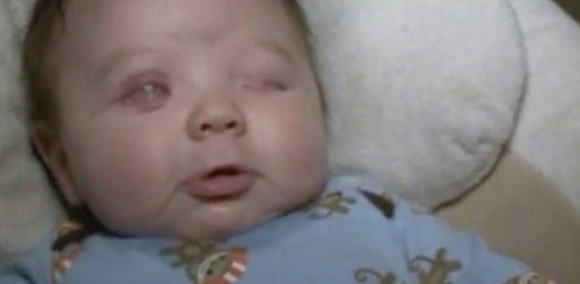Anophthalmia Leaves Newborn With No Eyes, But Transplant Advancements May Make Seeing Possible

At first glance, little Richie Lopez looks like any other sleeping baby. However, his mother noticed that something was off with her newborn son. Despite having perfect health and normal reflexes, the infant never opened his eyes. Upon closer examination, she found no eyeballs behind Richie’s eyelids. He was born with anophthalmia, a rare condition where no eye tissue forms. In dawn of 2015, however, scientific advancements in eye transplants have made it so that Richie’s eye absence may only be a temporary handicap.
Richie’s mother, Kelly Lopez, from Mesa, told Arizona news station KTV3 her initial thoughts upon discovering her son’s unique birth defect.
"I think we were just in shock. Obviously very upsetting," Kelly explained. "The first thought through your mind is, how did this even happen and how was it not even caught?"
Thirteen days after Richie’s birth, an MRI scan showed that the child did not have any eyeballs. Prosthetic eyeballs were his only option, and although this may change his appearance, they could do nothing to restore his sight.
Despite not having any eye tissue, though, Richie still has an optic nerve, so his mother is hopeful that one day eye transplant surgery may be a possibility.
“That would be amazing," his mother said. "I do hope that one day that they'll be able to either grow an eye or transplant an eye."
Although being blind is not as debilitating as the seeing world may perceive, many legally blind individuals are hopeful that science will help them to see, either again, or in Richie’s case, for the first time. Recently, scientific advancements suggest that this hope isn’t so farfetched.
"Until recently, eye transplants have been considered science fiction," explained Dr. Vijay Gorantla, an associate professor of surgery in the department of plastic surgery at the University of Pittsburgh, Healthday reported. "With what we now know about transplantation and, more importantly, nerve regeneration, we are finally at the point where we can have real confidence that this is something that actually can be pursued and eventually achieved."
The science behind an eye transplant is there — doctors can successfully take an eye from a donor and put it into another individual. The eye will continue to live with a constant flow of blood, but without reconnecting the organ to the optic nerve, the eye cannot see.
Optic nerve fibers do not re-grow once reconnected to blood vessels. However, according to Dr. Jeffrey Goldberg, director of research at the Shiley Eye Center at University of California, San Diego, regeneration of optic nerve fibers in animal studies gives hope that the same will be possible in humans. However, it’s likely to be a bit of time before this type of operation is available to the public, Goldberg says.
For now, little Richie is fitted with baby sunglasses to protect his exposed sockets until he has grown enough to be fitted with prosthetic eyes, but his mother remains hopeful that a new option will one day be available.



























